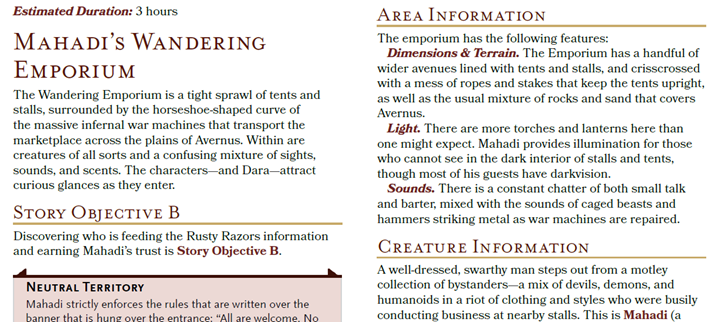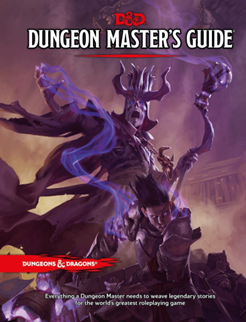It’s tricky writing adventures that are easy to prepare.
M. T. Black recently posted on Twitter that he wanted to allow DMs to prepare DDAL09-04 in as little as 15 minutes. While most DMs should spend an hour or more prepping a four-hour adventure before they run it, the reality of running adventures in a convention or store setting often means that the DM is called in at the last minute, or they have to prep seven adventures for the weekend and have limited time to prepare them.
Even when the DM has enough time to prepare an adventure, it’s unlikely that they memorise the entire thing.
Thus, it is extremely important to write adventures in a clear manner that makes it easy to find the crucial details the DM needs to run them while at the table.
There’s a school of thought that believes that this means you have to limit the complexity of encounters and the entire adventure’s structure. I don’t believe that is always necessary: Far more important is how you present the information. If there’s a good summary of what’s going on in the encounter, and it’s easy to find the specific details, then even more complicated scenarios can become much easier to run. (You generally should limit the complexity of individual encounters in any case, just because it’s very easy to overcome the DM with too many things to keep track of at once).
I’m currently prepping DDAL09-05 “Faces of Fortune” for use next weekend, so I thought I’d pull out a few passages from it and examine how they present the information. These examples are generally not bad – I’d just like to have a look at how I’d prefer them to be presented.
Here’s the “What do they want” section from an NPC description:
What Do They Want? The three salamanders genuinely enjoy the crafting and maintenance of the massive mechanical creations that power their travels. They’d be more than happy to do so indefinitely, but there is always a shortage of parts that Mahadi doesn’t really seem willing to correct. The three speak only Ignan and often complete each other’s sentences, so talking with them can be challenging. If the characters can overcome the communication difficulties, they may be able to strike a deal with the trio.
One of the crucial things to remember when writing an adventure is that everything should be written as it pertains to the Player Characters. The NPCs don’t exist except when the DM is bringing them to life in their interactions with the PCs. I believe that the first sentence should strike to the heart of the matter. What do they want? The salamanders would like more parts for repairs, as Mahadi hasn’t provided a sufficient supply. If the players can source more parts or tell the salamanders where to find more, the salamanders tell the players what they know, or may offer other appropriate aid.
The other details – that they’re happy, they speak only Ignan, and they complete each other’s sentences, would probably work better in a Personality or Role-playing section, something missing from the format.
Compare to this one:
What Do They Want? Elliach doesn’t recognize the characters or Dara, and thus hopes that they’ll be able to assist his experiments.
That’s great: straight to the point! I know immediately what Elliach wants. (There are more details later in this section, but they’re well-presented and irrelevant to the example).
I’ve noted before the importance of the opening paragraph for any encounter. Have a look at this excerpt from the adventure:

The opening paragraphs of an encounter section should give guidelines to the DM as to how to start running the encounter (and an idea of the shape of it). This is absolutely the place to indicate that Mahadi greets the characters as they arrive. You can put the full text on Mahadi later, but without that there’s a LOT of text for the DM to hunt through before finding what actually happens when the players enter. (I’d also have Mahadi called out with a subheading in the Creature Information section, to make it easier to find that information).
You can also see this in the opening encounter – the Call to Action – where it begins with boxed text, then lists the Area Information and the Creature Information before describing to what actually happens in the “Call to Action” section. So, it’s not consistent where to look to find out what’s going on.
I want to stress that this is by no means a bad adventure, nor does it seem to lack the information to run it. I’m looking forward to running it, as it seems quite entertaining. I’m just noting things in it that I’d prefer if they were presented differently.
One other thing: Don’t hide information from the DM. While it’s a good tactic in a novel to not reveal everything at once, if an NPC is a traitor, that needs to go in the introduction to the adventure if it affects the structure, and certainly in the role-playing notes for the NPC when first introduced. Don’t have it turn up several encounters later as a complete surprise to everyone! (This does not occur in this adventure, as far as I know.)

